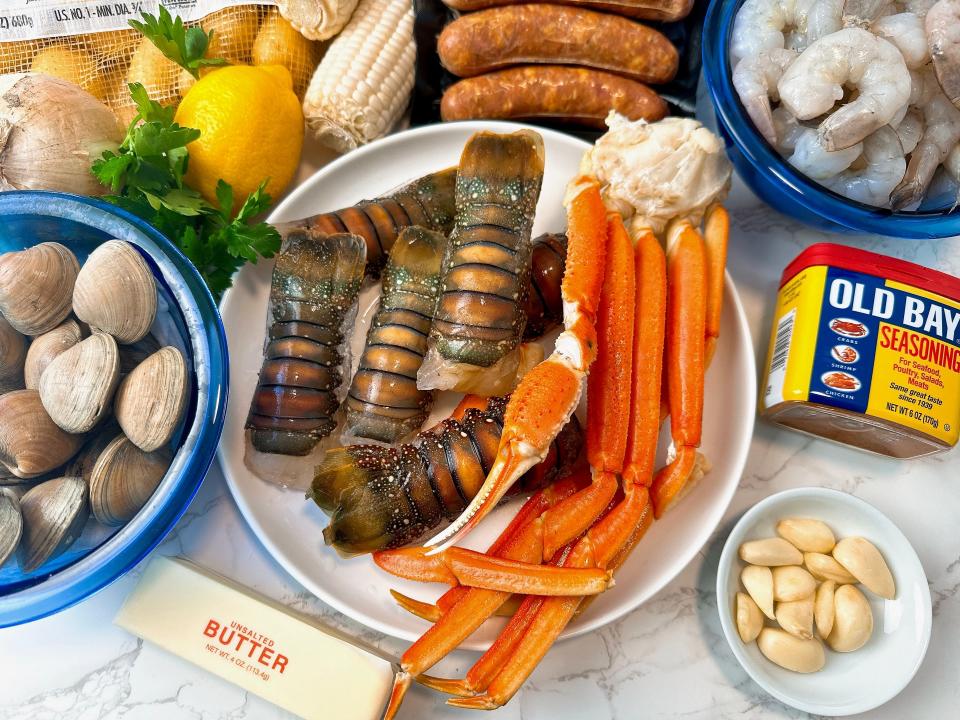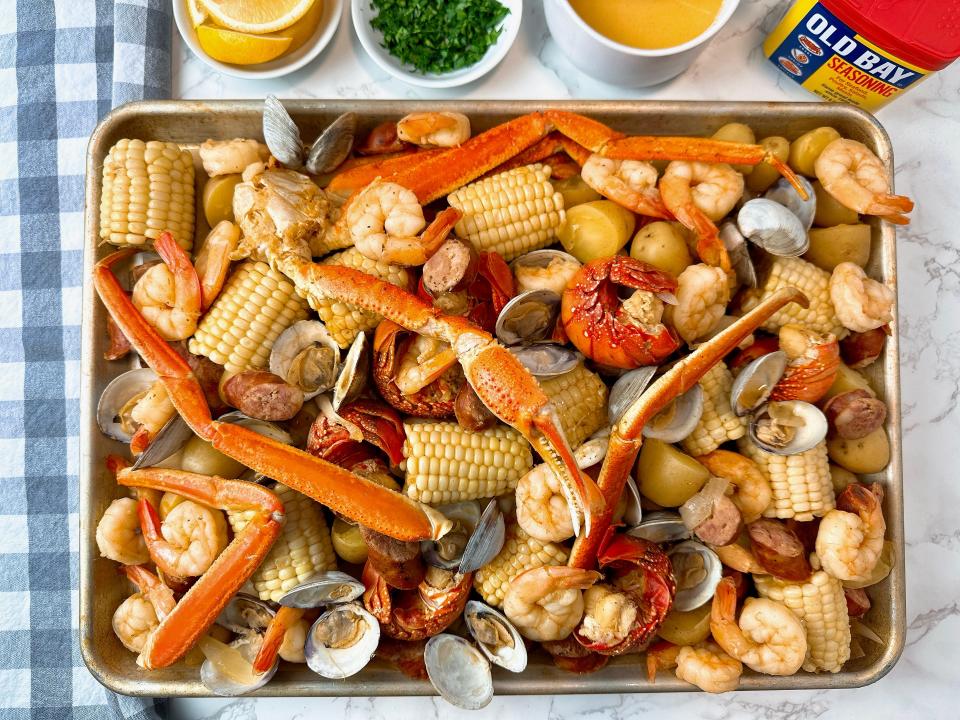Seafood boil is the absolute easiest one-pot summer feast. Here's how to make it
A bounty of fresh seafood simmered in an ultra-flavorful broth with smoky sausage and heaps of aromatic vegetables — the classic seafood boil never disappoints. Each bite delivers a variety of tastes and textures, but let’s be honest, it’s the presentation that really steals the show.
This seafood boil contains lobster, shrimp, clams, crab legs, potatoes, corn and sausage. Each element adds to the beauty of the dish. Sweet shellfish and corn, earthy potatoes, smoky sausage and a savory, herby broth boil together for the definitive one-pot meal that goes straight from the cooktop to the dinner table.
It’s easy, hearty, and virtually foolproof, but I have some suggestions to guarantee you make the best seafood boil every time.
What is a seafood boil made of?
A seafood boil is an excellent dish for stretching expensive ingredients like lobster, shrimp, and crab because they’re partnered with more affordable items like potatoes and corn. That said, purchasing an abundance of fresh seafood can get pricey.
Frozen seafood is often significantly less expensive than its fresh counterpart, so choose frozen lobster, shrimp and crab and you’ll save a bundle.
Thaw frozen seafood overnight in the refrigerator. If you forget to thaw your lobster tails and shrimp, speed up thawing by rinsing them under cold water for about five minutes.
For the other elements, use fresh corn. While frozen corn is convenient (and clearly an option when fresh isn’t available), you can’t beat the sweetness of fresh cob corn in this dish. You can use white, yellow or bicolor. Choose small red, yellow or white potatoes. I used baby yellow potatoes, but small red and white potatoes are also excellent options.
And opt for mild or spicy sausage. I chose Andouille sausage, a garlicky, herby sausage with a little heat. For a milder option, try kielbasa.
Consider alternative seafood options. There are no hard rules when it comes to a seafood boil, so feel free to substitute as desired. Great options include mussels, scallops and chunks of firm-fleshed fish like swordfish, cod, halibut, mahi-mahi and monkfish.
Cowboy caviar is the coolest side: Here's how to make the ideal summer recipe

Choose the right size seafood for your boil
I prefer bigger shrimp (16/20 count per pound) in my seafood boil because they stand up to the chunkier pieces of lobster, corn and potatoes. But that’s just me; you can use any size shrimp you prefer (or whatever's on sale).
You can also use shell-on or peeled and deveined shrimp. Peeled and deveined shrimp are often pricier, but I love peeled shrimp with the tails on because they require less work, and the shrimp are easier to eat.
Buy small lobster tails. In my opinion, 3- to 4-ounce petite lobster tails are ideal for a seafood boil because they require no halving and the tails are the perfect size for the pot. Plus, petite tails make a great presentation.
If you prefer to use larger lobster tails, halve them lengthwise before cooking.
Go with affordable crab legs. I used frozen snow crab legs, but there are many other options. You can use Dungeness crab, king crab or spiny lobster tail. Pick your favorite or the least expensive option.
How to cook clams
If you're including clams in your boil (I like to use littleneck clams), be sure to clean them well. Remove any debris and grit from the outside of your clams and make sure there’s no grit inside the shells. Any sandiness will end up in your seafood boil and that’s no fun.
Soak your clams in cold water for 20 minutes, transfer to another bowl of cold water. Do this three times. Yes, that’s one hour of soaking. Trust me, it's worth it.
If desired, add salt water to the first bowl of cold water, as it mimics the sea and the clams are likely to open and clean themselves naturally. When moving the clams from one soaking bowl to the next, lift them from the cold water with your hands to transfer them (versus dumping the bowl into the next bowl) to ensure that any sand is left at the bottom of the bowl.
If any clams are open before soaking (and don’t close with gentle pressure) discard them. And once your seafood boil is finished cooking, discard any clams that haven’t opened.
How to make seafood boil
I said earlier that there are no rules, but using Old Bay Seasoning is the exception. Old Bay is a propriety blend of spices and the concoction was specifically formulated for seafood. There’s truly no substitute. You can use classic, hot or reduced sodium in this recipe. I used classic.
Be sure to use your largest stockpot or Dutch oven for this seafood boil, ideally one that’s at least 12 quarts. The goal is to have enough room for the ingredients to move around freely while cooking.
Add the ingredients in stages. The elements cook at different rates, so you need to add the seafood and vegetables at different times. As instructed below, start with the items that take the longest to cook, like root vegetables, and gradually add the rest of the ingredients based on their cooking times.
What goes with seafood boil?
Since a seafood boil contains protein, starch and vegetables, it’s often considered a complete meal.
If you’d like side dish suggestions, I recommend bread for soaking up the flavorful juices. Great options include a French baguette, sourdough bread or cornbread.
You can also add a fresh green salad, coleslaw, potato salad or steamed or roasted vegetables like broccoli and asparagus.
For dessert: To make this creamy vanilla ice cream recipe, all you need are 3 ingredients and a blender

Seafood boil recipe
Be sure to serve your seafood boil immediately. A seafood boil tastes best when freshly cooked. Plus, seafood is highly perishable, so plan to serve your seafood boil as soon as it’s ready. Leftovers should be refrigerated for no longer than two days.
Makes: 6 servings
Ingredients:
2 lemons, quartered, plus extra lemon wedges for serving
½ cup Old Bay seasoning, plus more for serving
8 cloves garlic, smashed
1 yellow onion, peeled and cut into 6 wedges
1 ½ pounds baby/small red, yellow or white potatoes, scrubbed clean and halved
4 ears cob corn, husked and cut into thirds
4-6 petite lobster tails, about 3-4 ounces each
16-18 Littleneck clams, scrubbed clean (see note above)
2 pounds extra-large shrimp (16/20 count), peeled and deveined (leave tails on), or shrimp of choice
1 pound pre-cooked crab legs, such as snow crab, king crab or Dungeness crab
12-16 ounces smoked sausage, such as andouille or kielbasa, cut into 1 ½-inch pieces
3 tablespoons butter
Chopped fresh parsley for serving
Instructions:
Fill a large pot with 14 cups of water. Add the 2 quartered lemons, Old Bay seasoning, garlic and onion. Set the pot over medium-high heat and bring to a boil.
Add the potatoes and corn and cook for 8 minutes. Add the lobster tails and clams and cook for 3 minutes. Add the shrimp, crab legs and sausage and cook for 2 to 3 minutes or until the shrimp are opaque and the clams have opened. Discard any clams that haven’t opened.
Use a fine mesh sieve to remove the seafood mixture from the pot, reserving 1 ½ cups of the broth. Transfer the seafood mixture to a large serving platter or baking sheet lined with parchment paper.
Whisk butter into the reserved broth. Pour some of the broth over the seafood and vegetables. Reserve the remaining broth for serving on the side.
Sprinkle everything with additional Old Bay seasoning, garnish with parsley and lemon wedges and serve.
Questions or comments? Email the culinary team at cooking@azcentral.com.
This article originally appeared on Arizona Republic: Seafood boil is the easiest summer recipe. Here's how to make it

